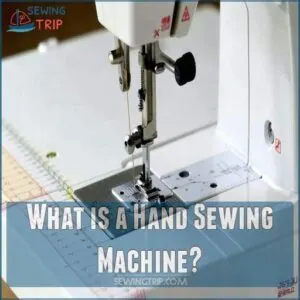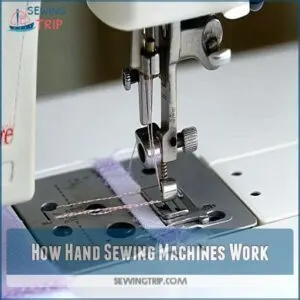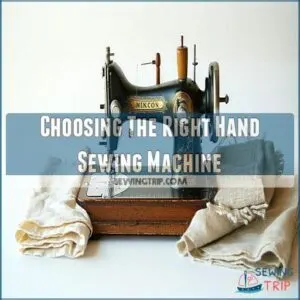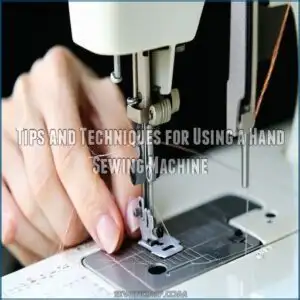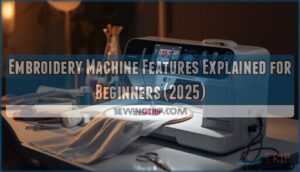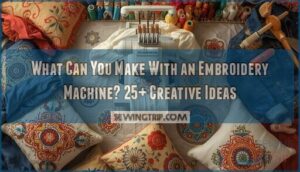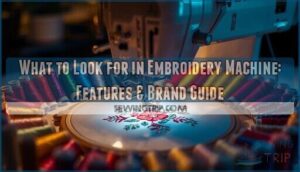This site is supported by our readers. We may earn a commission, at no cost to you, if you purchase through links.
 If you’re searching for a handy sewing solution that lets you stitch up quick fixes and small projects on the go, a hand sewing machine could be just the ticket.
If you’re searching for a handy sewing solution that lets you stitch up quick fixes and small projects on the go, a hand sewing machine could be just the ticket.
These nifty, battery-powered devices provide a compact, portable alternative to traditional sewing machines, offering a range of stitching capabilities in a convenient, handheld package.
Whether you’re mending a hem, attaching a button, or customizing your favorite garment, a quality hand sewing machine can make the job a breeze.
Keep reading to discover the top hand sewing machine options and learn how to find the perfect one for your sewing needs and budget.
Table Of Contents
Key Takeaways
- Choose a hand sewing machine that’s compatible with the fabrics you’ll be working with, considering weight and texture.
- Look for a compact, lightweight model with features like battery-power or corded operation to suit your portable sewing needs.
- Master the threading process and stitch quality adjustments to get the most out of your hand sewing machine.
- Properly maintain your hand sewing machine by cleaning, oiling, and replacing parts as needed to keep it running smoothly.
What is a Hand Sewing Machine?
Have you ever wished you could sew on the go?
Handheld sewing machines are compact, battery-powered wonders that let you tackle quick repairs and small projects anywhere.
These nifty tools are perfect for beginners and experienced sewers alike.
Definition and Basic Functionality
Imagine this: a sewing machine in the palm of your hand!
A hand sewing machine is perfect for quick fixes and projects with its compact size and battery power options.
They operate using a single thread mechanism, creating a chain stitch by guiding the thread through a needle and hook, making them ideal for hand sewing machine free clothing alterations.
While it specializes in straight stitch types on lighter fabric types, its portable charm and simple functionality make it ideal for on-the-go repairs, leaving you feeling like a sewing expert.
Differences From Traditional Sewing Machines
When you’re considering handheld versus traditional sewing machines, think about these differences.
Handheld models may lack power options for heavier fabrics but shine in stitch quality for quick fixes.
Traditional machines excel in tackling complex designs with their durability.
You’ll trade off versatility for portability, but both have unique strengths suited to your personal sewing projects.
Typical Uses and Applications
If you’re tackling a DIY project or need a quick clothing repair, a hand sewing machine can be your trusty sidekick.
It’s perfect for travel sewing or even crafting those quirky home decor items.
Check out the table below for common uses:
| Application | Example |
|---|---|
| Clothing Repair | Hemming pants |
| Craft Projects | Making bags |
| Travel Sewing | Fixing seams |
Advantages and Limitations
Hand sewing machines are great for quick repairs, offering versatility for simple tasks. They shine for small projects and on-the-go fixes.
However, they’re limited compared to full-sized machines. Durability can’t match traditional machines, and stitch quality may vary depending on fabric types.
- Cost-effective
- Highly portable
- Limited stitch options
How Hand Sewing Machines Work
You’ll discover how these handy machines feed the thread, creating stitches with a simple, usually single-thread mechanism.
Depending on the model, they’re powered by batteries or a cord, and the threading process is surprisingly straightforward, even for beginners!
Single Thread Feed Mechanism
The single thread feed mechanism in hand sewing machines is the heart of their operation.
Proper thread tension is essential, as seen in the chain stitch, where it can make or break the quality of the stitch.
learning how to thread a handheld sewing machine is essential to getting it right.
By looping the thread through the needle, it creates a secure stitch that holds your fabric together.
Get the threading just right, and you’ll enjoy smooth, consistent stitches every time.
Mastering basic stitches like the running stitch and backstitch, as well as choosing the right tools and supplies, such as selecting the right needles and thread, is crucial for a strong foundation. Mastering this simple yet essential technique is the key to hand sewing success.
Battery-operated Vs. Corded Models
When it comes to handheld sewing machines, a compact and lightweight design allows for easy transport and storage, perfect for sewing on the go with portable sewing machines. Choosing between battery-operated and corded handheld sewing machines boils down to your need for portability and power.
Battery life offers cordless convenience, perfect for quick repairs on-the-move.
Yet, consider charging time and costs, as batteries might require frequent replacements.
Corded models, on the other hand, provide consistent power, but you’ll need an outlet handy.
What’s your power preference?
Threading Process
Threading your hand sewing machine can be a breeze with a few simple steps.
First, locate the needle and carefully thread it from front to back.
Next, wind the bobbin and secure it in place.
Finally, adjust the tension dial to achieve the perfect stitch every time.
With a little practice, you’ll be sewing like a pro!
Stitch Formation and Types
Stitch formation on a hand sewing machine is a breeze once you get the hang of it.
These compact wonders use a single thread that loops through the fabric to create basic straight stitches.
While limited to straight stitches, you can adjust the tension and length to give your repairs a professional touch.
Benefits of Using a Hand Sewing Machine
Discover the convenience of hand sewing machines – they’re incredibly economical and functional, making them perfect for quick fixes and small projects.
With their super-portable design, you’ll be able to sew on the go with ease.
Economical and Functional
Ever felt like you’re playing tug-of-war with your sewing machine fund? Handheld sewing machines swoop in as saviors, balancing your budget effortlessly. They offer a wide range of options to fit your budget, and you can even check the current hand sewing machine price to make an informed decision. They offer:
- Budget-Friendly Sewing: Spend less, sew more without burning your wallet.
- Beginner-Friendly Projects: Tackling small tasks becomes a breeze.
- Beginner-Friendly Projects: is changed to Beginner-Friendly Projects: Tackling small tasks becomes a breeze -> Longevity and Portability: Get surprising longevity, even from compact models is changed to 3. Beginner-Friendly Projects: Tackling small tasks becomes a breeze -> 3. Beginner-Friendly Projects: Get surprising longevity, even from compact models -> is changed to 3. Longevity and Portability: Get surprising longevity, even from compact models -> Get surprising longevity, even from compact models -> 3. Get surprising longevity, even from compact models -> is changed to 3. Longevity and Portability: Get surprising longevity, even from compact models is changed to 3. is changed to 3. Longevity and Portability: Get surprising longevity, even from compact models is changed to 3. Longevity and Portability: Get surprising longevity, even from compact models -> Get surprising longevity, even from compact models -> 3. Get surprising longevity, even from compact models is changed to 3. is changed to 3. Get surprising longevity, even from compact models -> Longevity and Portability: Get surprising longevity, even from compact models -> is changed to 3. Get surprising longevity, even from compact models -> 3 is changed to 3. Get surprising longevity, even from compact models -> is changed to Get surprising longevity, even from compact models is changed to 3. is changed to 3. Get surprising longevity, even from compact models -> Get surprising longevity, even from compact models -> 3. is changed to 3. Longevity and Portability: Get surprising longevity, even from compact models -> 3 Get surprising longevity, even from compact models is changed to 3. **Longevity
Super Portable
With a hand sewing machine, you can pack up your sewing prowess and take it wherever life takes you.
These mighty marvels come in compact, lightweight designs – perfect for stashing in your luggage or purse.
Whether mending an errant seam or whipping up a quick accessory, a portable sewing machine opens up a world of on-the-go repair and creation.
| Dimensions | Weight | Power Source |
|---|---|---|
| 3" x 5" | 8 oz | Battery |
| 4" x 6" | 10 oz | USB/Corded |
| 5" x 7" | 12 oz | Battery/Corded |
Easy to Use
Taking your sewing adventures on the road just got a whole lot easier.
Handheld sewing machines are beginner-friendly and brilliantly simple to use.
Perfect for quick repairs and small sewing projects, they offer the ease needed for a first sewing machine.
Imagine effortlessly patching your favorite jeans while traveling—now that’s sewing freedom you can actually carry with you.
Full of Accessories
Handheld sewing machines aren’t just about simplicity; they’re packed with must-have accessories that make your sewing life easier.
These little helpers come with bobbins, needles, and even a threader, turning complex tasks into child’s play.
Imagine the surprise of finding everything you need in one nimble package, offering you both convenience and a touch of magic with each stitch.
Ideal for Quick Fixes and Small Projects
Your trusty handheld sewing machine is a lifesaver for DIY clothes repair and quick alterations.
Perfect for mending on the go and crafting simple projects.
Let’s stitch up the reasons why you’ll love it:
- Fix torn seams while traveling.
- Create simple crafts with ease.
- Keep clothes fresh with quick fixes.
- Ideal for a compact travel sewing kit.
- Stay prepared for unexpected wardrobe mishaps.
Top 7 Hand Sewing Machines for Beginners
Starting your sewing journey can be exciting and having the right hand sewing machine makes it even easier.
We’ve rounded up the top seven models perfect for beginners like you, offering user-friendly features and reliable performance to get those creative projects off the ground.
1. Singer Stitch Sew Quick Portable Mending Machine
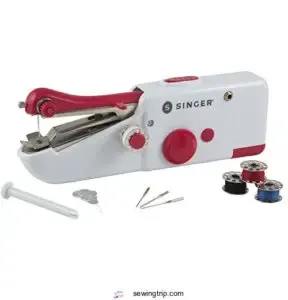
This Singer Stitch Sew Quick mending machine is a lifesaver for quick fixes.
It’s compact, battery-powered, and perfect for travel.
You’ll find it surprisingly powerful for its size, easily handling lightweight fabrics.
However, don’t expect miracles; it’s best for small repairs, not major projects.
The included needles and thread are a nice touch.
But, the on/off switch placement takes some getting used to.
Battery life could be better, and a power adapter would be a great addition.
Despite some quirks, it’s a handy tool to have around.
Best For: This Singer Stitch Sew Quick mending machine is best for those who need a compact, portable solution for quick fixes on lightweight fabrics.
- Compact and portable, perfect for travel
- Surprisingly powerful for its size
- Includes needles and thread for convenience
- Battery life could be better
- On/off switch placement is awkward
- Stitching can be erratic and may not hold
2. Brother XM2701 Sewing Machine
Frequently sewing enthusiasts flock to the Brother XM2701, a compact and lightweight machine perfect for beginners and advanced sewers alike.
This workhorse boasts 27 built-in stitches, an automatic needle threader, and a drop-in top bobbin for effortless operation.
You can easily find XM2701 accessories and parts online at Brother XM2701 products.
Its diminutive footprint belies its impressive capabilities, handling everything from repairs to small DIY projects with ease.
Backed by a generous 25-year warranty, the XM2701 is a reliable companion that will have you stitching with confidence, whether you’re tailoring clothes or crafting charming accessories.
Best For: The Brother XM2701 is best for beginners and experienced sewers who want an easy-to-use machine for basic projects and repairs.
- Lightweight and compact for easy storage and portability
- 27 built-in stitches offer versatility for various projects
- Backed by a 25-year warranty for peace of mind
- Limited to 120 volts, only suitable for use in the US
- May not be suitable for heavy-duty sewing or large projects
- Fewer advanced features compared to higher-end models
3. Singer Start 1304 Sewing Machine
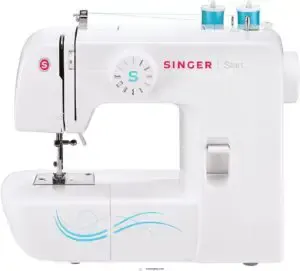
The Singer Start 1304 Sewing Machine is a versatile and user-friendly option for beginners getting started with sewing.
It is a lightweight and portable machine that packs a punch with its impressive 57 stitch applications and 6 different stitch types.
The automatic bobbin winding and reverse stitch feature make it a breeze to use, while the included accessories like the zipper foot and buttonhole foot help you tackle a variety of projects.
Whether you’re mending a torn seam or crafting a new accessory, the Singer Start 1304 is a reliable companion for your sewing adventures.
Best For: The Singer Start 1304 is perfect for beginners and anyone looking for a lightweight, easy-to-use sewing machine.
- Lightweight and portable
- User-friendly and well-suited for beginners
- Comes with a variety of accessories to help you tackle different projects
- Some users report initial difficulty threading the bobbin
- May not be suitable for advanced sewing projects
- Limited stitch options compared to more advanced machines
4. Janome Lilac Portable Sewing Machine
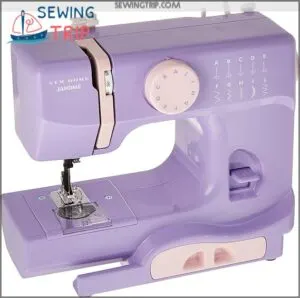
Imagine zipping through small repairs and alterations with ease, thanks to the convenience of a portable sewing machine small, which offers a compact and lightweight design perfect for quick fixes and on-the-go projects with the Janome Lilac Portable Sewing Machine, weighing in at just five pounds.
It’s perfect for beginners, offering 12 built-in stitches, including straight, zigzag, and crescent options.
This compact powerhouse features a free arm for tricky spots and handy accessory storage.
Like many top handheld sewing machines, it’s designed for convenience and portability.
With its easy reverse and top drop-in bobbin with a clear cover, setup becomes a breeze.
The presser foot sports a finger guard for safety, making this lilac gem a practical and friendly choice.
Best For: Beginners, crafters, and travelers looking for a lightweight and versatile sewing machine.
- Lightweight and portable design
- 12 built-in stitches for various sewing needs
- Easy setup with top drop-in bobbin and clear cover
- Limited stitch options compared to full-sized machines
- May not be suitable for heavy-duty sewing projects
- No automatic needle threader
5. Portable Sewing Machine with 12 Stitches
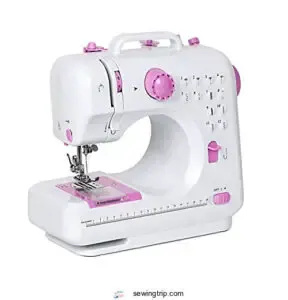
Ever wondered which portable sewing machine fits just right for beginners?
When shopping for a portable sewing machine that ticks all the boxes for convenience and versatility, consider the top picks for DIY enthusiasts outlined in small lightweight sewing machines. The NEX Portable Sewing Machine with 12 stitches might be your new best friend.
It’s lightweight, comes in a delightful shade of pink, and offers versatility with basic stitches for various purposes, such as the whip stitch for joining fabric edges, and offers versatility with stitch patterns for your home sewing projects.
Plus, it includes a foot pedal, a reverse stitch function, and bright workspace illumination.
Just a heads-up: it’s not the fastest out there, and handling thick fabrics can be tricky.
But hey, for small projects, it’s a charm!
To get started with basic sewing projects, it’s essential to practice hand sewing lessons for beginners. Best For: This portable sewing machine is best for beginners who want to try out basic sewing projects at home.
- Lightweight and portable
- Multi-purpose for home sewing projects
- Includes instructions and operating videos
- May not be suitable for thick materials
- Slower than other sewing machines
- Some users reported issues with the presser foot lever
6. Portable Mini Sewing Machine

Discover the Portable Mini Sewing Machine by Amazing Creations, a game-changer for quick fixes!
Compact and ergonomic, it’s perfect when you’re in a pinch.
With two machines in one, you’ll breeze through minor repairs sans batteries.
Its no-nonsense design means no special skills are required.
Equipped with bonus bobbins and needles, it’s a travel-friendly powerhouse.
While it may not replace your traditional sewing machine, it’s a handy companion for fast, on-the-go stitching.
Just a little practice, and you’re set!
Best For: This is ideal for quick fixes and minor sewing projects on the go.
- Compact and portable, perfect for travel.
- Easy to use, no special skills needed.
- Includes extra bobbins, needles, and other accessories.
- May not be effective for large projects.
- Some users found it difficult to use and not effective for large projects.
- Quality may be low and not durable.
7. Portable Hand Sewing Machine Kit

For crafty beginners on the go, a portable hand sewing machine kit delivers all the essentials in one tidy package.
This budget-friendly option includes a diminutive machine, thread, bobbins, needles, and scissors – everything you need for quick fixes and simple projects.
Though lightweight and compact, the sewing quality remains impressive, with easy threading and smooth stitching on fabrics like cotton, silk, and denim.
With a handy carrying case, this kit is a travel-friendly sidekick that empowers sewists to tackle repairs and customizations anywhere, anytime.
Best For: This portable hand sewing machine kit is best for beginners, travelers, and those seeking a convenient solution for quick fixes and simple projects.
- Compact and portable design for easy carrying
- Includes a wide range of accessories for basic sewing tasks
- Budget-friendly option for those just starting out
- May struggle with thicker fabrics
- Quality control issues have been reported, with some users receiving damaged or defective machines
- Instructions may be difficult to understand for some users
Choosing The Right Hand Sewing Machine
Choosing the right hand sewing machine can be a challenging task, but don’t worry – we’re here to help!
Consider factors like fabric compatibility, portability, power source, and your budget to find the perfect fit for your sewing needs.
Fabric Compatibility
How do you make sure your handheld sewing machine suits various fabrics?
Consider fabric weight and texture before sewing: lightweight materials like cotton or linen generally work best.
Use the right needle type and adjust stitch density for different fabrics.
Keep project scale in mind—these machines aren’t meant for heavy-duty tasks.
With these tips, you’ll nail any sewing project!
Portability and Size Considerations
For sewing on the move, portability and size are key.
Look for compact, lightweight models that won’t weigh you down.
Mini sewing machines with:
- Easy-to-grip handles for one-handed operation
- Slim profiles for tucking into travel bags
- Streamlined designs for efficient storage
- Protective cases to keep your machine safe
These portable powerhouses let you tackle quick fixes and small crafts anywhere, from the road to the couch.
Power Source Options
Balancing battery life and cordless convenience becomes vital when choosing a hand sewing machine.
Think about power adapter compatibility and power cord length, especially if you’re always on the move.
A quick charging time means fewer interruptions in your sewing flow.
Consider your lifestyle—do you prefer freedom from wires or a trusty plug to keep you powered?
Additional Features and Accessories
Beyond the basics, look for handheld sewing machines with nifty add-ons.
Attachments like zigzag stitching feet, ruffler feet, and blind hem feet expand your creative possibilities.
Integrated lighting and precise thread tension dials help you always get a professional-looking finish, even on delicate fabrics.
Thoughtful extras like fabric guides and storage make sewing a breeze.
Budget Considerations
Finding the right price range for a sewing machine is like sewing a patchwork quilt—finding affordable options isn’t just about cost, but value.
Budget-friendly brands offer machines that don’t break the bank while still delivering a decent stitch.
Consider your fabric needs, power sources, and features to snag a model that offers the best value for money without compromising on essentials.
Tips and Techniques for Using a Hand Sewing Machine
Using a handheld sewing machine takes a bit of practice, but once you get the hang of it, you’ll be whipping up quick fixes and small projects like a pro.
From mastering the threading process to achieving consistent stitch quality, we’ve got the tips and techniques you need to make the most of your compact sewing companion.
Proper Fabric Preparation
To get your fabric ready for sewing on a handheld machine, start by pre-washing it.
This helps remove any sizing or finishes that could impact your stitches.
Then, iron the fabric to remove wrinkles and make sure it has a smooth, flat surface.
Mastering The Threading Process
Your hand sewing machine’s threading process is the key to getting the most out of it. Master these simple steps, and you’ll be sewing like a pro in no time:
- Locate the threading guide – it’s your roadmap to thread success.
- Insert the thread through the tension discs for good tension.
- Wind the bobbin with care, ensuring an even, tangle-free spin.
- Thread the needle with a steady hand for a smooth, reliable stitch.
- Double-check your work – a little attention to detail goes a long way.
Achieving Consistent Stitch Quality
Achieving consistent stitch quality on your handheld sewing machine takes a bit of practice, but it’s key to creating professional-looking results.
Pay close attention to needle size, fabric tension, and stitch length.
Mastering the bobbin winding and speed control will also help you sew with precision.
Stay patient, and you’ll be stitching like a pro in no time.
| Factors | Tips |
|---|---|
| Needle Size | Select the right needle size for your fabric thickness |
| Fabric Tension | Adjust the thread tension knob to achieve even stitches |
| Stitch Length | Experiment to find the ideal stitch length for your project |
| Bobbin Winding | Make sure the bobbin is wound evenly and securely |
| Speed Control | Start slow and gradually increase speed for best results |
Troubleshooting Common Issues
Having trouble with your handheld sewing machine? No need to fret!
Common issues like needle problems, such as a dull or damaged hand sewing machine needle, fabric jams, thread tension woes, or even a finicky battery can often be resolved with a few simple tweaks.
Try rethreading, adjusting the tension, or checking for obstructions.
Stay patient, and your mini machine will be humming along in no time.
Maintenance and Care
To keep your handheld sewing machine humming, wipe it down after each use and store it in a protective case.
Regularly check and replace the needle to guarantee smooth, consistent stitches.
Lubricate the moving parts as directed to prevent binding and extend the machine’s lifespan.
With a little TLC, your trusty sidekick will stitch on for years to come.
Frequently Asked Questions (FAQs)
Are hand sewing machines any good?
Handheld sewing machines can be great for basic repairs and quick projects, but they’re no replacement for a full-size machine if you’re doing serious sewing.
Portability and convenience matter most when using a handheld sewing machine.
Is hand sewing as strong as machine sewing?
Ever wonder if hand sewing is as strong as machine sewing?
The truth is, while machine sewing creates a more permanent, durable stitch, hand sewing can be just as sturdy for certain projects if done properly.
The key is technique and thread quality.
Is a manual sewing machine better?
Actually, a manual sewing machine isn’t necessarily better – it depends on your needs.
Manual models are budget-friendly and portable,
while electric machines provide more power and versatility for complex projects.
Consider your sewing goals to decide which is right for you.
How do you use a hand held sewing machine?
You simply place the fabric under the needle, turn on the machine, and guide the fabric as it sews.
The key is taking it slow and steady – no need to rush through your projects.
With some practice, you’ll be a hand sewing pro in no time!
What maintenance does a hand sewing machine require?
Treat your trusty sidekick well.
Regularly dust the casing, oil the moving parts, and clear any lint or thread buildup.
This’ll keep your handheld humming and ready for your next creative adventure.
Can a hand sewing machine sew thick fabrics?
No, hand sewing machines aren’t well-suited for sewing thick fabrics.
These compact, portable devices work best with lightweight materials like cotton, silk, or linen.
Thicker fabrics like denim or leather may overwhelm the limited power and capabilities of a hand sewing machine.
How long does the battery last in a hand sewing machine?
The battery life in a handheld sewing machine can typically last 3-6 hours on a single charge, depending on the model and usage.
Rechargeable batteries are available on some machines for added convenience.
What accessories come with a typical hand sewing machine?
What accessories come with a typical hand sewing machine?
You’d be surprised – most kits include a variety of bobbins, needles, threads, and even a cute carrying case to keep everything organized and ready to go.
Can a hand sewing machine be used for heavy-duty projects?
Nope, handheld sewing machines aren’t built for heavy lifting.
They’re great for quick fixes, but thicker fabrics?
They’ll likely struggle.
Think of them as sewing’s handy Swiss Army knife, not a power tool.
Conclusion
With this detailed guide, you’re ready to select the perfect hand sewing machine that fits your creative needs and budget.
Whether you’re a busy parent mending clothes on the go or a crafting enthusiast exploring new projects, these portable powerhouses offer convenience without compromising functionality.
Remember to think about fabric compatibility, power options, and your specific requirements when making your choice.
Your ideal hand sewing machine awaits – time to start stitching your way to success!

